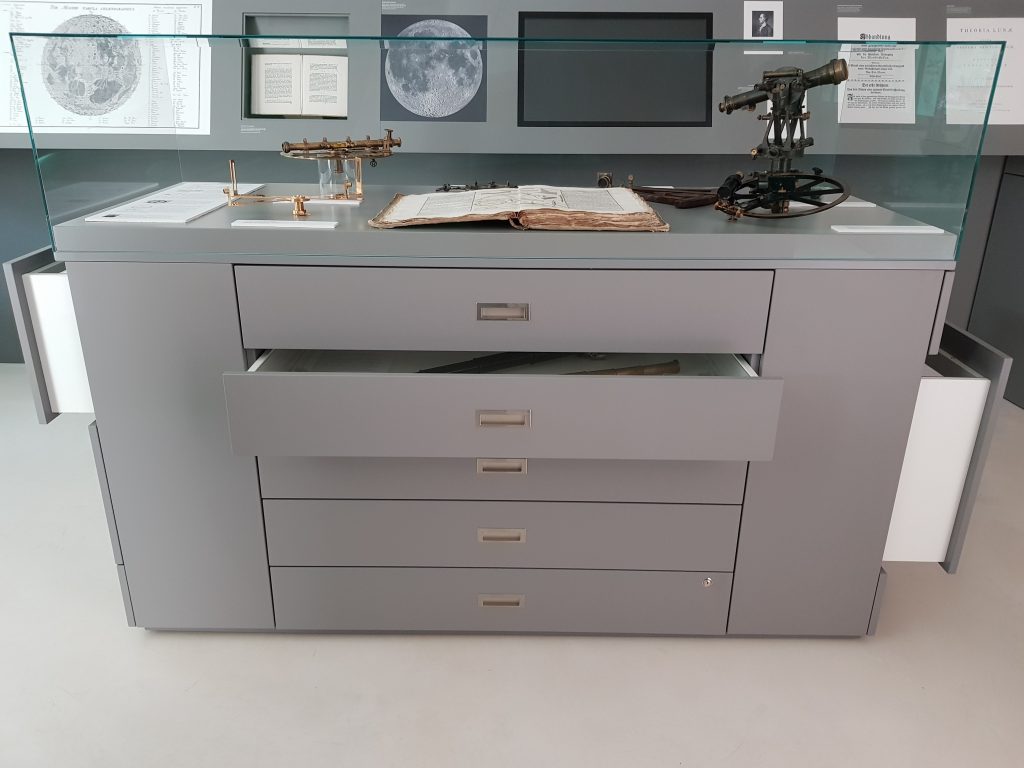
Positioning instruments
Tobias Mayer never went to sea, but he thought about how to measure his position early on. In his Mathematical Atlas of 1745, he presented instruments on table 11 that he later had made for measuring angles.
The showcase shows the mathematical atlas and to the left of it his own instruments in replicas: a so-called reciprocating angel and his so-called astrolabe, a full-circle angle device. Above the atlas is a traditional astrolabe, as it was used before Mayer, to the right of an octant is a full circle, which is a further development of Mayer’s full circle and a later theodolite. All instruments were used to measure angles, which were essential for determining the position. In the drawers that can be opened there are other instruments that were used to determine the position. Some are devices from the time before Mayer, such as a cross staff and a large astrolabe, and some are later developments such as a theodolite, a sextant or a modern GPS device. You can also find telescopes, compasses and sundials in the drawers.
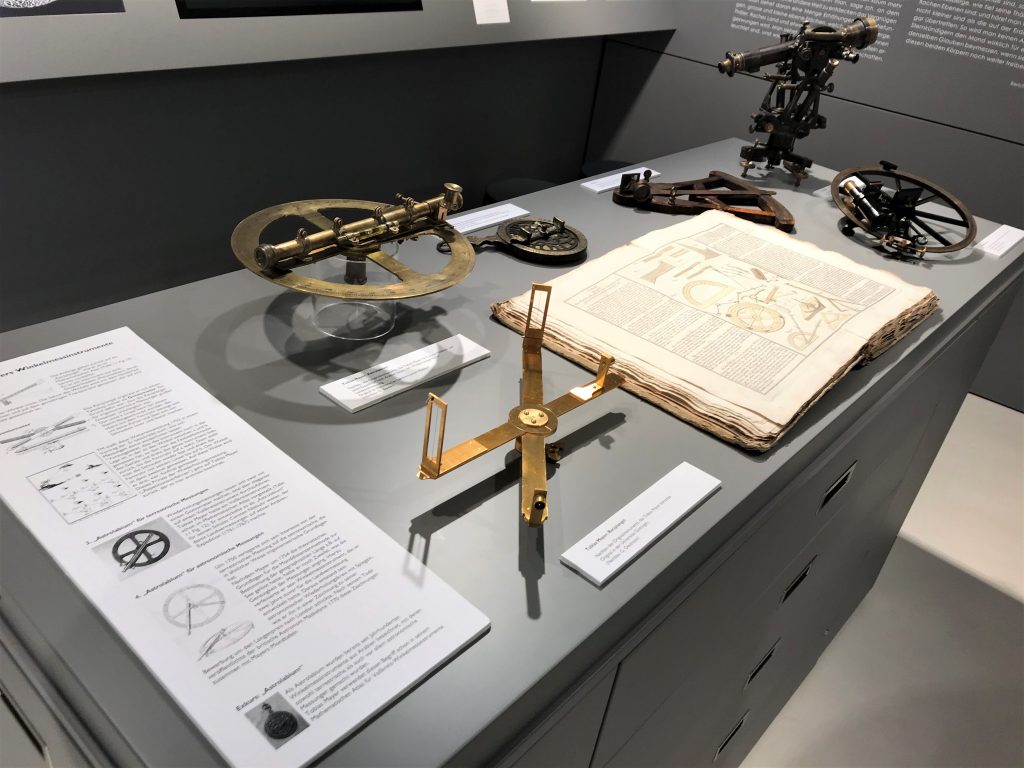
| 2. The instruments on the showcase Tobias Mayer: Recipient Replica of the original instrument that Tobias Mayer used. Original in the University of Göttingen. (Replica: Günther Oestmann) Tobias Mayer: Astrolabe Replica of the original instrument that Tobias Mayer had built for Carsten Niebuhr and his expedition to Arabia. Angle measuring device for national surveying. Original in the Dithmarscher Landesmuseum Meldorf. (Replica: Dieter Baader) The angle measuring instrument, which was put on a wooden stick and fixed in the ground for the national survey, was made by Mayer for his student Carsten Niebuhr, who took it with him on his trip to Arabia. Niebuhr’s Jemenkarte is still considered to be a masterpiece of early geographical research in Arabia. The term repetition circle is derived from the fact that repeated measurements were made on a 360 ° scale in order to rule out errors in measuring or inaccuracies in the graduation of the instrument. Astrolabe The starry sky can be reproduced with an astrolabe. With a diopter on the back you can measure the elevation angle of an object on earth or in the sky. Astrolabes were used from ancient times to the early modern period. Full circle Lorieux Further development of the Mayer angle measuring instrument, reflection circle, mirror full circle with telescope. Manufacturer Lorieux / Seine around 1900. (Gift from Erhard Anthes) Octant Angle measuring instrument with mirrors based on an eighth circle, mainly used in seafaring. (Replica of a device from the 18th century) Theodolite Angle measuring device for measuring horizontal and vertical angles. Manufacturer La Filotecnica-Salmoiraghi Milan, year of construction approx. 1910. (Gift from Dieter Baader) |
Please also take a look at the measuring instruments in the drawers
3. The front drawers
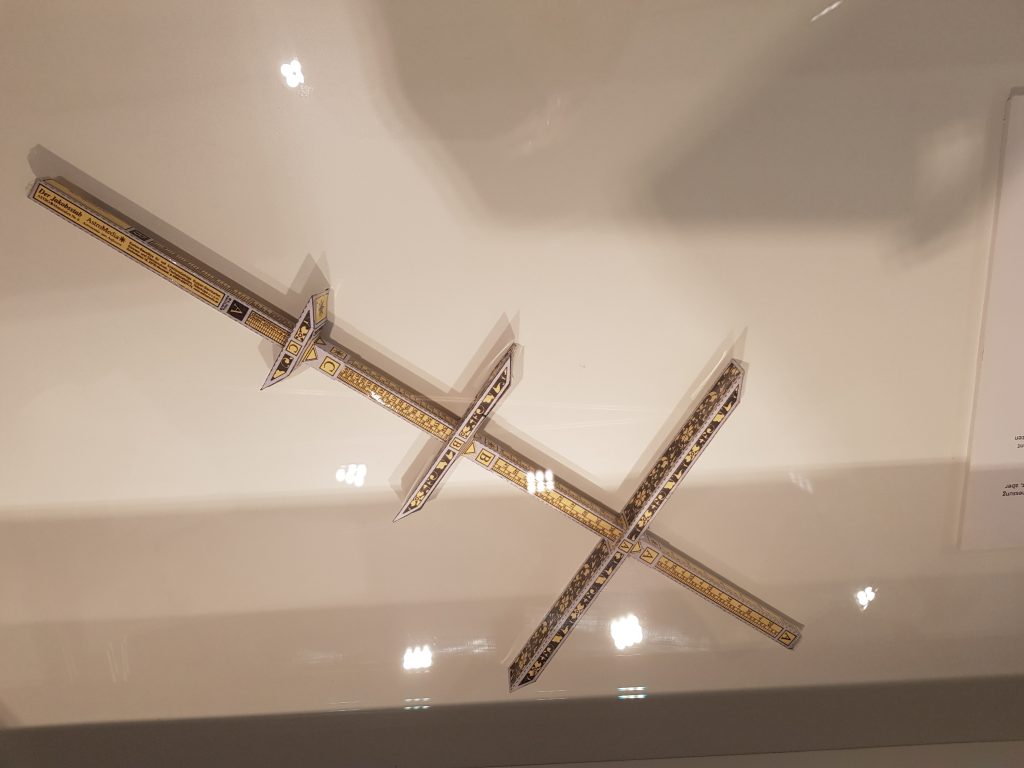
Jacob’s staff
A Jacob’s staff is an earlier astronomical instrument for angle measurement and indirect distance measurement. It was mainly used in seafaring, but also in land surveying and astronomy. The Jacob’s staff was the forerunner of the sextant in nautical science. The device on display was recreated by Günther Oestmann in 2020.
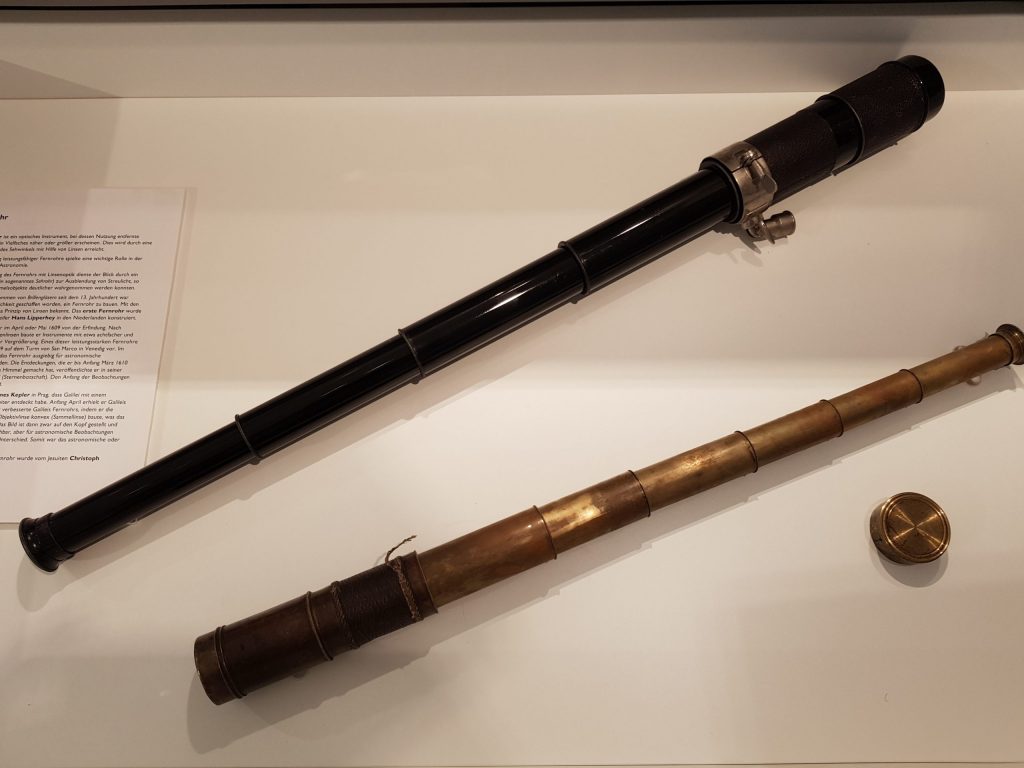
Telescopes
A telescope is an optical instrument which, when used, makes distant objects appear many times closer or larger. This is achieved by increasing the angle of vision with the help of lenses.
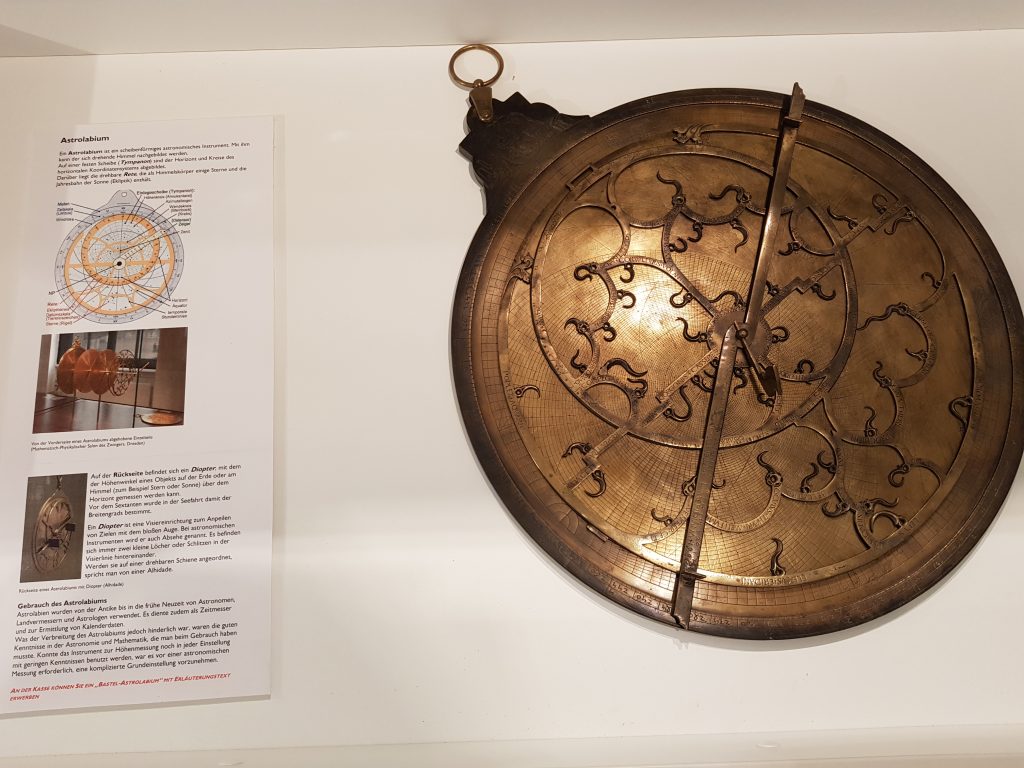
Large astrolabe
An astrolabe is a disc-shaped astronomical instrument. It can be used to simulate the rotating sky. The instrument is a gift from Jürgen Hamel. You can purchase a “handicraft astrolabe” with explanatory text at the cash register.
4. The drawers on the right
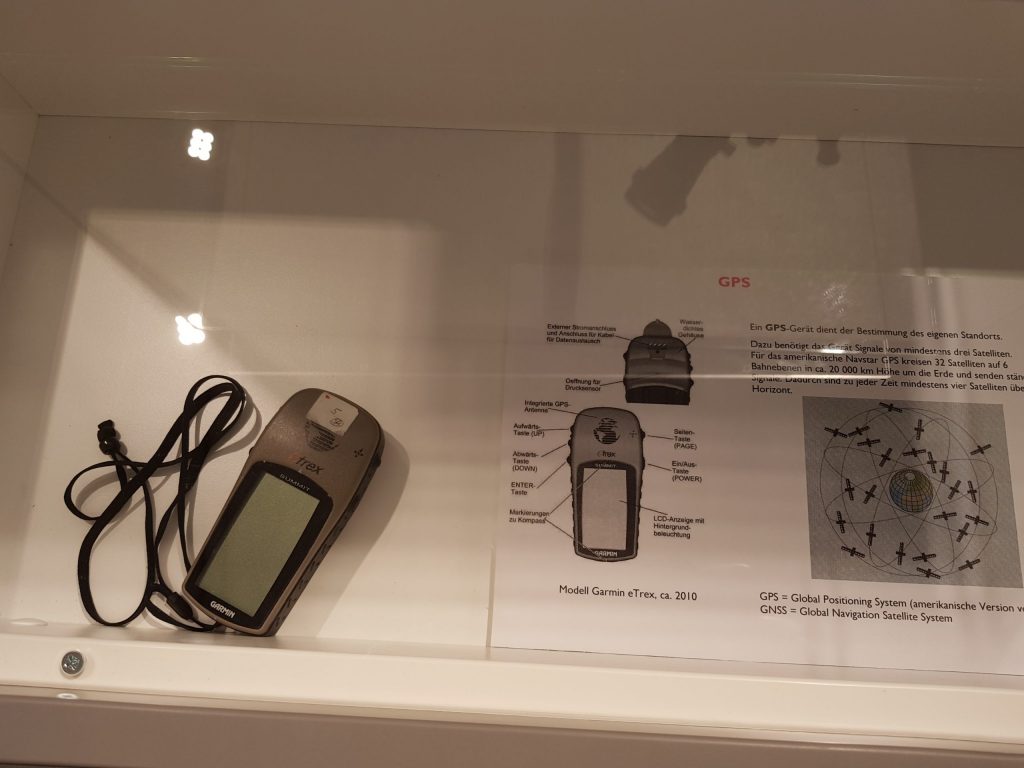
GPS
A GPS device is used to determine your own location. To do this, the device needs signals from at least three satellites.
Theodolite
A theodolite is an angle measuring instrument that is used in land surveying to determine horizontal or vertical angles. It is set up on a tripod perpendicular to the reference point.
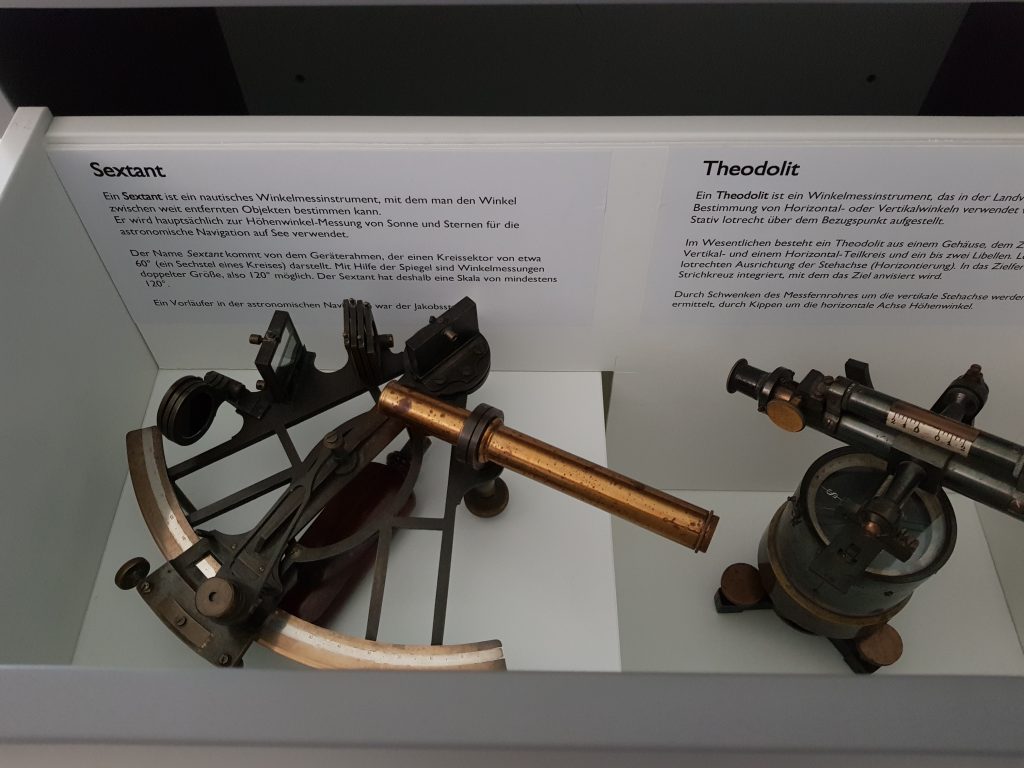
Sextant
A sextant is a nautical angle measuring instrument that can be used to determine the angle between distant objects. The instrument is a gift from Erhard Anthes.
5. The drawers on the left
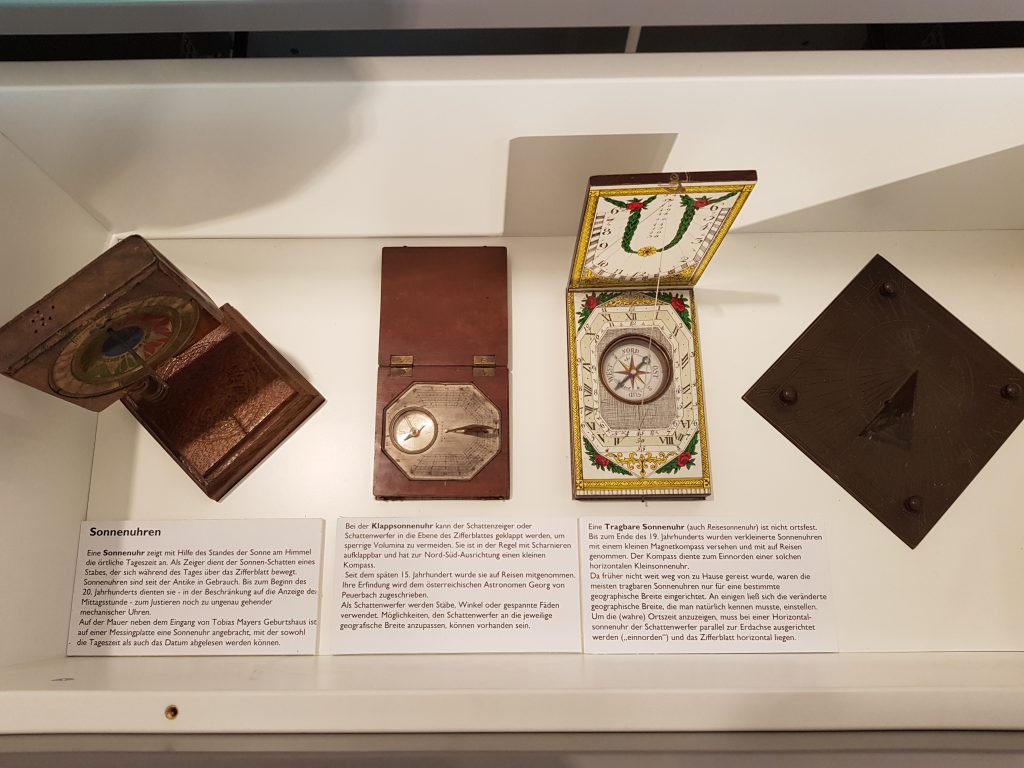
Sundials A sundial shows the local time of day with the help of the position of the sun in the sky. The sun’s shadow of a stick, which moves across the dial during the day, serves as a pointer. |

Ship compass
The compass is an instrument for determining a fixed direction, e.g. B. compass direction, navigation course, bearing direction.
Background information
The beginnings of Tobias Mayer’s measuring instruments go back to a „recipiangel“, as he already presented in the Mathematical Atas (Table 11 Fig. 13). It is an instrument made up of two diopter rulers (target disks), the opening of which measures the angle. The chord of the angle is taken off with the hand-held compass and measured on the straight feeder, which is drawn on one of the rulers.
He added a telescope to the recipients as a goniometer. One reason for this was that the reciprocity for trigonometric measurements of long distances was insufficient.
The lower ruler can be screwed (on a tripod), the upper one with the telescope moves around its axis and can be made looser and tighter with screws.
Tobias Mayer presented this further development in a lecture in 1752. He also describes how measurements can be repeated with it:
“Provided that the instrument is still in the position in which it has measured the angle between a and b, then you loosen the locking screw of the device and turn the whole instrument back to the left until the telescope is at a. Then you tighten the screw again and turn the telescope with your ruler up to b. The angle is then measured twice. This way it is measured three, four, five times. … „
This principle of repeated measurement („repetition method“) goes back to Tobias Mayer, who first described it here.
Repeat measurements can be made with a goniometer, but are more elegantly carried out on a full-circle instrument. Tobias Mayer had already presented a full circle instrument in the Mathematical Atlas (panel 11, fig. 12). He further developed it as an „astrolabe“ for his student Carsten Niebuhr, who used it to make land measurements on his expedition to Arabia (1761-1767).
Around 1750 his interest shifted from terrestrial measurement to astronomical, which similarly has trigonometric bases. After Mayer developed the theoretical basis for the lunar distance method for determining geographical longitude around 1754, e.g. had resolved at sea, he still had doubts about the accuracy of the measurements. To do this, he refined his angle measuring instrument, which he had developed two years earlier for land surveying. This resulted in his astronomical repetition circle with mirrors, as he sent it to London in a drawing for his application for the length price. After his death, the British astronomer Maskelyne published these drawings in 1770 together with Mayer’s lunar tables.
